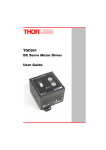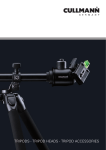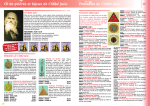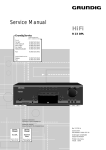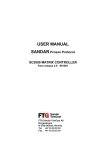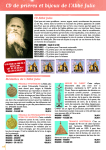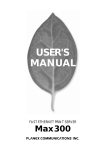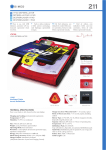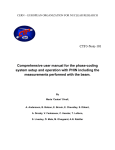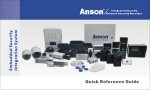Download MAX300 Series NanoMax 3-Axis Flexure Stage User Guide
Transcript
MAX300 Series NanoMax 3-Axis Flexure Stage User Guide Contents Chapter 1 Safety ............................................................................................. 3 1.1 Safety Information .................................................................................. 3 1.2 General Warnings .................................................................................. 3 Chapter 2 Introduction ................................................................................... 4 2.1 Description of the NanoMax TS 3-Axis Flexure Stage ........................... 4 2.2 Component Identification ........................................................................ 4 Chapter 3 Operation ....................................................................................... 8 3.1 Manual Differential Drives and Differential Micrometer Drives ............... 8 3.2 NanoStep Motor Drives .......................................................................... 8 3.3 Piezo Actuators ...................................................................................... 9 Chapter 4 Installation ................................................................................... 10 4.1 4.2 4.3 4.4 4.5 4.6 4.7 4.8 Unpacking ........................................................................................... 10 Attaching to a Work Surface ................................................................. 10 Calibration of Motor Drives................................................................... 10 Fitting and Removal of Drives .............................................................. 11 Orienting the Moving Platform .............................................................. 12 Mounting Equipment. ........................................................................... 13 Transportation. ..................................................................................... 13 Dimensions ........................................................................................... 14 Chapter 5 Specifications ............................................................................. 17 Chapter 6 Parts and Consumables ............................................................. 18 6.1 Parts List .............................................................................................. 18 Chapter 7 Regulatory ................................................................................... 19 7.1 Declarations Of Conformity .................................................................. 19 7.2 Waste Electrical and Electronic Equipment (WEEE) Directive ............. 20 Chapter 8 Thorlabs Worldwide Contacts ................................................... 23 2 HA0094T Rev 11 April 2011 Chapter 1 Safety 1.1 Safety Information For the continuing safety of the operators of this equipment, and the protection of the equipment itself, the operator should take note of the Warnings, Cautions and Notes throughout this handbook and, where visible, on the product itself. The following safety symbols may be used throughout the handbook and on the equipment itself. Shock Warning Given when there is a risk of injury from electrical shock. Warning Given when there is a risk of injury to users. Caution Given when there is a risk of damage to the product. Note Clarification of an instruction or additional information. 1.2 General Warnings Warnings If this equipment is used in a manner not specified by the manufacturer, the protection provided by the equipment may be impaired. In particular, excessive moisture may impair operation. Spillage of fluid, such as sample solutions, should be avoided. If spillage does occur, clean up immediately using absorbant tissue. Do not allow spilled fluid to enter the internal mechanism. 3 Chapter 2 Introduction 2.1 Description of the NanoMax TS 3-Axis Flexure Stage The NanoMax 3 axis flexure stage has been designed to integrate seemlessly into the Thorlabs Modular Electronic System and provide nanometric positioning on three orthogonal axes. It is suited to the alignment of optical fibres, waveguides, optoelectronic packages and any other high resolution alignment or positioning application including general purpose laboratory tasks. The innovative flexure design, combined with the system of modular drives, offers exceptional performance and flexibility. Three types of drive are available, the DRV001 stepper motor drive, the DRV3 differential micrometer and the DRV004 thumbscrew. Also available are two external piezo actuators which increase the piezo travel to 40 µm or 100 µm. 2.2 Component Identification 2.2.1 NanoMax Stage The NanoMax-TS 3 axis flexure stage is available in three versions; piezo-actuated with feedback on all axes, piezo-actuated without feedback and without piezo actuation, as shown in Fig. 2.1 to Fig. 2.4. SMC connectors 7-pin LEMO connectors CAUTION 75 V DC MAX DRIVE VOLT AGE P/N MAX301 Fig. 2.1 MAX301 NanoMax piezo-actuated stage with feedback on all axes 4 MAX300 Series 3-Axis Flexure Stages SMC connectors CAUTION 75 V DC MAX DRIVE VOLTAGE P/N MAX302 Fig. 2.2 MAX302 NanoMax piezo-actuated stage without feedback The piezo-actuated models deliver 20 microns of travel, each piezo channel has a coaxial SMC connector (see Fig. 2.1 and Fig. 2.2). In addition, the NanoMax 301 has a 7-pin LEMO connector for each feedback channel (see Fig. 2.1). A corresponding number of leads for connection to the Thorlabs piezoelectric controllers are also supplied.The piezo-actuated models deliver 30 microns of travel, with a coaxial SMC connector for each piezo channel. The pin functions for the Lemo connectorare detailed below. 5 4 6 1 7 2 3 Pin Description 1 2 3 4 5 6 7 +15 V Oscillator + 0V Sig Out Sig Out + -15 V Travel Fig. 2.3 Feedback Lemo connector pin functions 5 Chapter 2 CAUTION 75 V DC MAX DRIVE VOLTAGE P/N MAX303 Fig. 2.4 MAX303 NanoMax without piezo-actuation The NanoMax 303 has no electrical connections. 2.2.2 Drives and Actuators There are three types of drive available for the NanoMax, a motorized drive as shown in Fig. 2.5. and two manual drives as shown in Fig. 2.6. In addition, external piezo actuators are available to give an additional 20 µm or 80µm piezo travel – see Fig. 2.7.. Note The DRV001 stepper motor drive must be used in conjunction with the BSC benchtop driver or the MST601 control module. It cannot be driven by the TST001 T-Cube driver. Fig. 2.5 DRV001 NanoStep motor drive 6 HA0094T Rev 11 April 2011 MAX300 Series 3-Axis Flexure Stages DRV3 differential micrometer drive DRV004 thumbscrew drive Fig. 2.6 Manual Drives These external piezo actuators can be fitted in-line with the standard drives described on the previous page. The DRV120 provides an additional 20 µm of piezo travel. The DRV181 gives 80 µm of travel. DRV120 External piezo actuator with feedback 8 DRV181 External piezo actuator without feedback Fig. 2.7 External piezo actuators 7 Chapter 3 Operation 3.1 Manual Differential Drives and Differential Micrometer Drives 3.1.1 Adjusting Micrometer Drives Turn the coarse adjustment clockwise until the platform of the NanoMax begins to move. By use of the fine adjustment, sub-micron resolution is now achievable. 3.1.2 Reading Micrometer Drives 50 μm per rev 1.0 μm per division coarse adjuster (8 mm) (4 mm on stage) fine adjuster (300 μm) Fig. 3.1 Reading micrometer drives 3.2 NanoStep Motor Drives When used together with a Thorlabs stepper motor Controller, the NanoStep motor drives allow fully automatic control of the NanoMax. Basic steps in controlling the stage are as follows: 1) Set commands to configure each axis (setting velocities, accelerations etc.) – see the handbook for relevant stepper motor controller. 2) Move each axis to its home position, to establish a zero datum. 3) Set commands to move each axis by relative and absolute amounts – see APTServer Helpfile. A default configuration is set at the factory and stored in the non-volatile memory of the motor controller – see Table 3.1. 8 MAX300 Series 3-Axis Flexure Stages Table 3.1 Standard configurations for motor drives Parameter Value Maximum Velocity 2.5 mm s-1 Minimum Velocity 1 mm s-1 Slope 1 mm s-2 1 –0.01 mm Linear 40000 3 mm 0.00 mm 4.00 mm Backlash control Backlash distance Mode Microsteps to units Offset Minimum position Maximum position Notes The NanoStep modular drives have no +ve limit switch. The drive reaches a mechanical stop at a position dependent on the axis to which it is attached. The design is such that occasional driving into the stop will not cause any damage. If the axis is driven towards the –ve limit switch, at a certain position the platform stops moving while the drive itself continues to move until the limit switch is reached. The drive must then be moved positively by a certain distance before the platform begins to move. This distance is just less than the offset. When creating a program to control the NanoMax, it is preferable to avoid running into the +ve limit. 3.3 Piezo Actuators Piezo actuators are used to give nanometric positioning of the top platform over a range of 20 microns (40 µm or 100 µm if external piezo actuators are used). They can also modulate the position of the platform at high frequency. On a piezo-actuated NanoMax, position feedback may be incorporated on the linear axes to enhance the repeatability and linearity of piezo motion. The piezo-actuated NanoMax should be used together with one of the Thorlabs piezoelectric controllers – see the handbook for the relevant piezoelectric controller. The NanoMax monitors the ambient temperature using thermistors and applies small movements to the stage to compensate for the expansion and contraction of metals within the stage. Note that this compensation is active only when the associated piezo controller is set to ‘closed loop’ (feedback on) mode – see the relevant piezo controller handbook for more details on the operation of piezo actuators. 9 Chapter 4 Installation 4.1 Unpacking Note Retain the packing in which the unit was shipped, for use in future transportation. Caution Once removed from its packaging, the NanoMax is easily damaged by mishandling. The unit should only be handled by its base, not by the top platform or any attachments to the top platform. 4.2 Attaching to a Work Surface The base of the NanoMax is provided with a number of fixing holes and slots for attachment to metric or inch optical tables, as supplied by Thorlabs and other manufacturers. Bolting the unit down minimizes the risk of damage from dropping. When mounting the NanoMax close to other equipment, ensure that the travel of the moving platform is not obstructed. If the moving platform is driven against a solid object, damage to the internal flexures could occur. The range of travel on each axis is 4 mm total, that is ± 2 mm about the nominal position. 4.3 Calibration of Motor Drives Note This section is applicable only to motor drives when a calibration has been requested. Calibration enables the server to correct for any mechanical errors inherent in the system. Mechanical components, such as the leadscrew and linkages, can be machined only within a certain tolerance, e.g. the leadscrew may be nominally 1mm but actually 1.0005mm, giving a 0.5 micron error. In practice, these errors accumulate from a number of sources, however they are repeatable and therefore, can be compensated. During calibration, the total positional error is measured at a large number of points and these errors are stored as a look up table (LUT). The LUT is saved as a calibration file, one file for each axis on a particular stage. These files are then linked to the appropriate axis as part of the Stage association process performed using the APT Config utility. Whenever the stage is moved, the LUT is consulted to ascertain the precise movement required to achieve the demanded position. 10 MAX300 Series 3-Axis Flexure Stages When the stage is calibrated at the factory, the stepper motor controller, channel number, motor, stage and axis are configured in a certain manner. For the calibration to be effective, it is important to re-assemble the stage with the motors fitted to the same axis for which they were calibrated. This information is contained in the table below. Furthermore, the correct calibration files must be associated with the correct stage axis. In this regard, it is important to confirm what stage axes are connected to particular channels on particular motor units. It is then a simple task to use the APT Config utility to associate the correct calibration file with a particular serial numbered hardware unit and channel. The use of a calibration file is optional. Without it, the repeatability and resolution of the stage are unaffected, but no compensations are made to enhance the accuracy Details on assigning a calibration file are contained in the APTConfig On Line Helpfile. Table 4.1 Calibration details NanoMax serial number Axis Motor Serial number Calibration File X Y Z Remarks 4.4 Fitting and Removal of Drives This section is applicable only to Part Numbers MAX301, MAX302 and MAX303. The following procedure details how to fit a drive to the NanoMax 300 stage. A micrometer drive is shown for illustration purposes but the procedure is equally applicable to motor or thumbscrew actuators. 1) For manual drives, rotate the coarse adjuster counter-clockwise a few turns to retract the drive rod. For motor drives, retract the drive rod by turning the manual adjuster clockwise. Then, referring to Fig. 4.1 on the next page... 2) Insert the drive into the mounting bush. 3) Tighten the knurled locking ring until finger tight. Note To remove a drive reverse the above procedure. When removing a motor drive, rotate only the locking ring, do not rotate the motor body. 11 Chapter 4 mounting lock ring coarse adjustment locking screw fine adjustment moving plate coarse adjustment mounting bush fixed body drive rod Fig. 4.1 Micrometer drive inserted into mounting bush 4.5 Orienting the Moving Platform The stage is normally oriented such that the X axis is the optical axis. If it is necessary to change the orientation for left or right-handed use, the Y axis becomes the optical axis as shown in Fig. 4.2 (The Z axis is always vertical). X Optical axis Z X Y Z Y left handed right handed Fig. 4.2 Platform orientation 12 HA0094T Rev 11 April 2011 MAX300 Series 3-Axis Flexure Stages 4.6 Mounting Equipment. Caution When attaching accessories (e.g. fiber holders) to the top platform or angle brackets (e.g. AMA007 and AMA009) to the side of the unit, do not use long bolts which protrude into the internal mechanism as this could cause damage to the internal flexures. The weight attached to the moving platform must not exceed 1 kg. Do not apply excessive forces to the moving platform. Thorlabs manufacture a variety of fibre chucks, holders and fixtures to fit the NanoMax stage. However, custom hardware can be designed using a tongue-ingroove arrangement and the cleats provided, see Fig. 4.3 for a typical fixture. all dimensions in mm optical axis 3.0 (0.12) typical slot each side for mounting cleats P as required 3.0 (0.12) 3.0 (0.12) typical 1.3 (0.05) 14.55 (0.57) 2.95 (0.12) 32.0 (1.26) Fig. 4.3 Typical fixture, view along X-axis, length as required 4.7 Transportation. Caution The drives should be removed before transporting the NanoMax. When packing the unit for shipping, use the original packing. If this is not available, use a strong box and surround the NanoMax with at least 100 mm of shock absorbent material. 13 Chapter 4 4.8 Dimensions 4.8.1 Top Platform 60.0 (2.36) all dimensions in millimetres (inches) 3 Pitches of 15.00 (0.59) = 45.0 7.5 (0.3) 17.0 (0.67) 17.0 (0.67) 10.0 (0.39) 4.0 (0.16) 10.0 (0.39) 30.0 (1.18) 3.0 (0.12) 17.0 (0.67) 5.3 (0.21) 5.3 (0.21) 17.0 (0.67) 10.0 (0.39) 20.0 (0.79) 20.0 (0.79) 10.0 (0.39) (0.3) 3 Pitches of 15.00 (0.59) = 45.0 7.5 60.0 (2.36) 1.6 (0.06) 5.3 (0.21) 5.3 (0.21) 20.0 (0.79) 20.0 (0.79) 30.0 (1.18) (0.06) 1.6 3.00 (0.12) A 60 (2.36) 7.5 (0.3) 20 (0.79) 60 (2.36) 20 (0.79) B holes M3 (6-32 UNC) Product No AMA001 AMA003 AMA005 A 28 (1.10 35 (1.38) 45 (1.77) B 12 (0.47) 12 (0.47) 14 (0.55) extended top platform Fig. 4.4 Dimensions – top platform 14 HA0094T Rev 11 April 2011 MAX300 Series 3-Axis Flexure Stages 4.8.2 External Piezo Actuators DRV120: 82.0 nominal 26.0 ±4 nominal reach DRV181: 126.0 nominal Fig. 4.5 External piezo actuators 4.8.3 Modular Drives all dimensions in millimetres (inches) 112.5 (4.43) 42.0 (1.65) DRV001 stepper motor drive 26.0 ±4 (1.02 ±0.16) nominal reach 1.13 (28.7) nominal reach 2.24 (56.8) DRV3 micrometer differential drive 0.31 (8.0) Travel 27.5 (1.08) Ø19 (0.75) DRV004 thumbscrew drive 26.0 ±4 (1.02 ±0.16) nominal reach Fig. 4.6 Dimensions – modular drives 15 Chapter 4 4.8.4 NanoMax 3-Axis Stage all dimensions in millimetres (inches) 1.7 (0.06) 11 30 (1.18) (0.43) 42.6 30 (1.18) (1.68) 56.5 (2.22) 3.0 (0.12) 87 (3.43) 98 (3.86) 112 (4.41) 93 (3.66) 105.6 (4.16) 17.4 (0.69) 4.8 (0.19) 62.5 (2.46) 105.6 (4.16) 93 (3.66) 42 (1.65) 21 (0.83) 87.0 (3.43) 98.0 (3.86) Fig. 4.7 Dimensions – NanoMax 3-axis stage 16 HA0094T Rev 11 April 2011 MAX300 Series 3-Axis Flexure Stages Chapter 5 Specifications .. Parameter Weight (without drives): Load capacity: Travel Resolution Arcuate displacement (maximum): Value 800 g 1 kg Manual (coarse) and motor4 mm Manual (fine)300µm Piezo20 micron Manual (coarse)0.5mm per revolution Manual (fine)50µm per revolution Motor0.06 µm min incremental movement Piezo (without feedback)20 nm Piezo (with feedback)5 nm 80 micron Note The resolution of a manual drive corresponds to a 0.5 degree adjustment of the thimble; the actual resolution obtained depends on the skill of zthe user. The resolution of the motor drives is the smallest step that can be executed (i.e. 1 microstep). The resolutions of the piezo actuators are those typically obtained using Thorlabs controllers. Power supply Piezoactuated NanoMax Nominal maximum input voltage:75 V Stepper Motor Absolute maximum input voltage:100 V Maximum input voltage:24 V Caution The NanoMax should only be used in conjunction with the appropriate Thorlabs Piezoelectric Controllers. 17 Chapter 6 Parts and Consumables 6.1 Parts List Part Number Description MAX316D and MAX316D/M MAX315D and MAX315D/M NanoMax stage with differential micrometer drives NanoMax stage with piezo actuator and differential micrometer drives NanoMax stage with feedback piezo actuator and differential micrometer drives. NanoMax stage with stepper motor drives. NanoMax stage with piezo actuator and stepper motor drives. NanoMax stage with feedback piezo actuator and stepper motor drives. NanoMax stage only NanoMax stage with piezo actuator NanoMax stage with feedback piezo actuator. SMC connector lead LEMO connector lead Mounting cleat Cable clamp Handbook MAX314D and MAX314D/M MAX343 and MAX343/M MAX342 and MAX342/M MAX341 and MAX341/M MAX303 and MAX303/M MAX302 and MAX302/M MAX301 and MAX301/M 166038 134667 131030 120992 ha0094T 18 Chapter 7 Regulatory 7.1 Declarations Of Conformity 7.1.1 For Customers in Europe This equipment has been tested and found to comply with the EC Directives 89/336/EEC ‘EMC Directive’ and 73/23/EEC ‘Low Voltage Directive’ as amended by 93/68/EEC. Compliance was demonstrated by conformance to the following specifications which have been listed in the Official Journal of the European Communities: Safety EN61010: 2001 Installation Category II, Polution Degree II. EMC EN61326: 1997 7.1.2 For Customers In The USA This equipment has been tested and found to comply with the limits for a Class A digital device, persuant to part 15 of the FCC rules. These limits are designed to provide reasonable protection against harmful interference when the equipment is operated in a commercial environment. This equipment generates, uses and can radiate radio frequency energy and, if not installed and used in accordance with the instruction manual, may cause harmful interference to radio communications. Operation of this equipment in a residential area is likely to cause harmful interference in which case the user will be required to correct the interference at his own expense. Changes or modifications not expressly approved by the company could void the user’s authority to operate the equipment. 19 Chapter 7 7.2 Waste Electrical and Electronic Equipment (WEEE) Directive 7.2.1 Compliance As required by the Waste Electrical and Electronic Equipment (WEEE) Directive of the European Community and the corresponding national laws, we offer all end users in the EC the possibility to return "end of life" units without incurring disposal charges. This offer is valid for electrical and electronic equipment • • • • • sold after August 13th 2005 marked correspondingly with the crossed out "wheelie bin" logo (see Fig. 1) sold to a company or institute within the EC currently owned by a company or institute within the EC still complete, not disassembled and not contaminated Fig. 7.1 Crossed out "wheelie bin" symbol As the WEEE directive applies to self contained operational electrical and electronic products, this "end of life" take back service does not refer to other products, such as • • • • pure OEM products, that means assemblies to be built into a unit by the user (e. g. OEM laser driver cards) components mechanics and optics left over parts of units disassembled by the user (PCB's, housings etc.). If you wish to return a unit for waste recovery, please contact Thorlabs or your nearest dealer for further information. 7.2.2 Waste treatment on your own responsibility If you do not return an "end of life" unit to the company, you must hand it to a company specialized in waste recovery. Do not dispose of the unit in a litter bin or at a public waste disposal site. 20 HA0094T Rev 11 April 2011 MAX300 Series 3-Axis Flexure Stages 7.2.3 Ecological background It is well known that WEEE pollutes the environment by releasing toxic products during decomposition. The aim of the European RoHS directive is to reduce the content of toxic substances in electronic products in the future. The intent of the WEEE directive is to enforce the recycling of WEEE. A controlled recycling of end of life products will thereby avoid negative impacts on the environment. 21 22 Chapter 8 Thorlabs Worldwide Contacts USA, Canada, and South America Thorlabs, Inc. 435 Route 206 Newton, NJ 07860 USA Tel: 973-579-7227 Fax: 973-300-3600 www.thorlabs.com www.thorlabs.us (West Coast) email: [email protected] Support: [email protected] Europe Thorlabs GmbH Hans-Böckler-Str. 6 85221 Dachau Germany Tel: +49-(0)8131-5956-0 Fax: +49-(0)8131-5956-99 www.thorlabs.de email: [email protected] UK and Ireland Thorlabs Ltd. 1 Saint Thomas Place, Ely Cambridgeshire CB7 4EX Great Britain Tel: +44 (0)1353-654440 Fax: +44 (0)1353-654444 www.thorlabs.de email: [email protected] Support: [email protected] Scandinavia Thorlabs Sweden AB Box 141 94 400 20 Göteborg Sweden Tel: +46-31-733-30-00 Fax: +46-31-703-40-45 www.thorlabs.de email: [email protected] Japan Thorlabs Japan Inc. Higashi Ikebukuro Q Building 1st Floor 2-23-2 Toshima-ku, Tokyo 170-0013 Japan Tel: +81-3-5979-8889 Fax: +81-3-5979-7285 www.thorlabs.jp email: [email protected] China Thorlabs China Oasis Middlering Centre 3 Building 712 Room 915 Zhen Bei Road Shanghai China Tel: +86 (0)21-32513486 Fax: +86 (0)21-32513480 www.thorlabs.com email: [email protected] France Thorlabs SAS 109, rue des Côtes 78600 Maisons-Laffitte France Tel: +33 (0) 970 444 844 Fax: +33 (0) 811 381 748 www.thorlabs.de email: [email protected] 23 Thorlabs Inc. 435 Route 206 North Newton, NJ07860 USA Tel: +1 973 579 7227 Fax: +1 973 300 3600 www.thorlabs.com 24 Thorlabs Ltd. Saint Thomas Place, Ely Cambridgeshire CB7 4EX, UK Tel: +44 (0) 1353 654440 Fax: +44 (0) 1353 654444 www.thorlabs.com
























